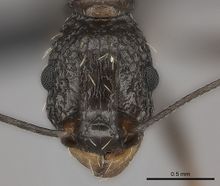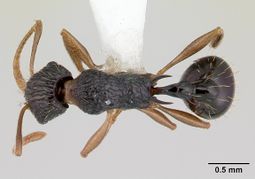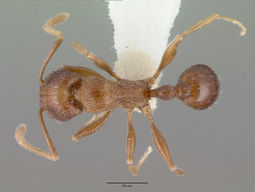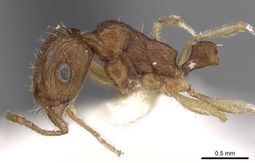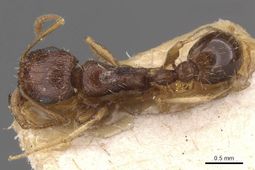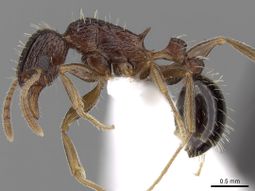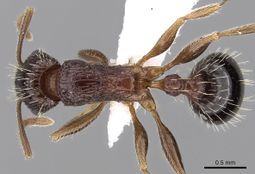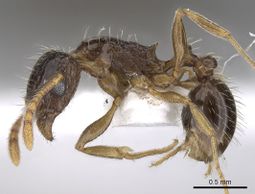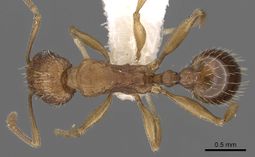Key to Afrotropical Tetramorium setigerum species group
This worker key is based on Bolton (1980)[1]
You may also be interested in
1
- Scapes exceptionally long, SI>150 . . . . . 4 (perlongum) species complex
- Scapes long, but shorter 100<SI<120 . . . . . 2
2
return to couplet #1
- Propodeum in profile armed with a short pair of triangular teeth, which at most are as long as their basal width and similar in size to the metapleural lobes, sometimes unarmed . . . . . 3
- Propodeum in profile armed with a pair of very long spines which are slightly downcurved along their length and which are much longer than the eye diameter . . . . . 5 (youngi) species complex
3
return to couplet #2
- Frontal carinae feeble, only developed to the level of the posterior margins of the eyes and thereafter fading out or becoming confused with the sculpture . . . . . 6 (doriae) species complex
- Frontal carinae strongly developed, almost reaching the occipital margin. The carinae are usually surmounted by a raised rim or flange for most or all of their length . . . . . 8 (setigerum) species complex
4
return to couplet #1
- Entire dorsum of head and alitrunk with all spaces between rugae packed with coarse reticulate-punctate sculpture. SI 154-162 ..... Tetramorium dolichosum
- Dorsum of head and alitrunk with scattered rugulae, the spaces between which are smooth or at most with vestigial ground-sculpture. SI 174-180 ..... Tetramorium perlongum
5
return to couplet #2
- Longitudinal rugulae on dorsal head without cross-meshes and without anastomoses or reticulation occipitally; ground-sculpture between the rugulae almost effaced, the surfaces virtually smooth. SI 105..... Tetramorium youngi
- Longitudinal rugulae on dorsal head with scattered cross-meshes, the occipital region with distinct anastomoses or a reticulum; ground-sculpture between the rugulae weak but fairly conspicuous. SI 111- 113..... Tetramorium metactum
6
return to couplet #3
- With the head in full-face view the sides behind the eyes without projecting hairs. Base of first gastral tergite faintly reticulate or punctulate ..... Tetramorium praetextum
- With the head in full-face view the sides behind the eyes with projecting hairs. Base of first gastral tergite smooth . . . . . 7
7
return to couplet #6
- Pronotal dorsum with a rugoreticulum or partial reticulum present at least anteriorly, the entire pronotal surface with rugulose sculpture ..... Tetramorium doriae
- Pronotal dorsum mostly unsculptured, with a few feeble meandering rugulae which nowhere form a reticulum, most of pronotum devoid of sculpture ..... Tetramorium gracile
8
return to couplet #3
- Mandibles smooth and shining, unsculptured except for small pits ..... Tetramorium agile
- Mandibles distinctly longitudinally striate or rugulose . . . . . 9
9
return to couplet #8
- Promesonotal dorsum smooth and very shining, without trace of punctulate sculpture and usually also without rugulae although sometimes a couple of feeble and very widely spaced rugulae may be present ..... Tetramorium laevithorax
- Promesonotal dorsum distinctly sculptured with rugulae and conspicuous punctulation . . . . . 10
10
return to couplet #9
- Maximum diameter of eye 0.28- 0.31 x HW. If at lower end of this range then other measurements as follows: HW 0.68-0.72, CI 77- 83, SL 0.70-0.80 ..... Tetramorium setigerum
- Maximum diameter of eye 0.25-0.28 x HW. If at upper end of this range then other measurements as follows: HW 0.58-0.67, CI 81- 86, SL 0.62-0.70 . . . . . 11
11
return to couplet #10
- Petiole node in profile with both anterodorsal and posterodorsal angles bluntly rounded, the anterior and posterior faces of the node distinctly convergent dorsally. Base of first gastral tergite smooth ..... Tetramorium avium
- Petiole node in profile with the anterodorsal angle a sharp right-angle which often projects into a low peak or crest. Posterodorsal angle more obtuse but well developed, the anterior and posterior faces only slightly convergent dorsally. Base of first gastral tergite with a band of fine punctulation or shagreening, weak in some individuals ..... Tetramorium frenchi
References
<References>


